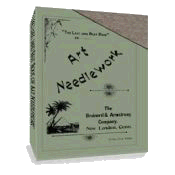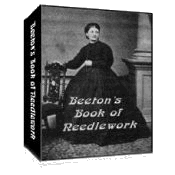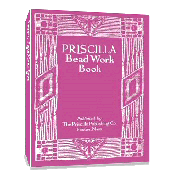Tinsel Embroidery
Tinsel Embroidery is worked upon net, tulle, and thin muslin materials, and is an imitation of the Turkish Embroideries with gold thread upon crepe. The patters are in outline, and consist of geometrical or arabesque designs, which should be simple, and with lines rather wide apart.
To work:
To begin Tinsel embroidery, trace the design upon pink calico, which back with brown paper, and upon this tack the net. Take the very narrowest tinsel, thread it on to a wool needle, and work it backwards and forwards along the outlines. Put it in below a line, and bring it out above it in a slanting direction to the right, slant it again, and put it in below the line, and press it down with the thumb, so that it rather overlays itself, and forms the line as a series of Vandyke Stitches. Work in floss silk and in Satin Stitch such parts of the pattern that are too small for the tinsel lines.
Tinsel can be used instead of gold thread in embroideries upon velvet, brocade, and silk, but, as it soon tarnishes, the latter is the best to employ for good work.
Tinsel Threads
Metallic threads and cords in gold, silver, copper and various tinsel effects were often used in artistic needle-work in the late 1880’s and early 1890’s. They were sometimes employed separately, but more frequently they were associated with silk, chenille and crewel.
Tinsel Fabric
A term used to signify a thin and loosely-woven material, formed partly or entirely of gold and silver threads, and introduced into embroidery, but chiefly employed for theatrical purposes. The dress of the harlequin is composed entirely of tinsel. We find allusions to this bright and sparkling material in some of our classical authors. Tinsel could be purchased in thin sheets for application to Net, Gauze, and Velvet, or for the wrappers of bonbons and crackers.
An Interesting Historical Note: The use of Tinsel was limited in the reign of Henry VIII to certain ranks amongst the nobility, and according to a Sumptuary Law, “No man under the State of an erle were in his apparel of his body or horse, any cloth of gold or silver, or tinceld satin.”
Return to the top of Tinsel Embroidery page.
Return to Types of Embroidery page.
Return to Home page.



 433 pages!
433 pages!

